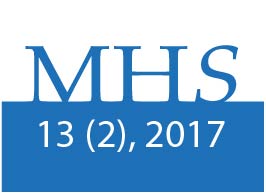Retraso de la latencia de activación de los músculos vasto medial oblicuo y vasto lateral en individuos con síndrome de dolor patelofemoral
DOI:
https://doi.org/10.15359/mhs.13-2.1Palavras-chave:
síndrome de dolor patelofemoral, latencia muscular, tiempo de reacción muscular, electromiografía.Resumo
Propósito: determinar la latencia de activación de los músculos vasto medial oblicuo (VMO) y vasto lateral (VL) en individuos con síndrome de dolor patelofemoral (SDPF). Metodología: Estudio de casos y controles. Un total de14 participantes femeninos con SDPF y 15 participantes femeninos sin SDPF realizaron una prueba de perturbación repentina de los miembros inferiores en dirección anterior y posterior. Durante esta se midió la latencia de activación electromiográfica de los músculos VMO y VL. Se utilizó la prueba t de student para comparar la latencia muscular entre los grupos. Se consideró un nivel alfa de 0,05. Resultados: Durante una desestabilización anterior, se observó un retraso significativo en la latencia de activación de los músculos VMO (p < 0,001) y VL (p = 0,019) en los participantes con SDPF. Cuando fueron sometidos a una desestabilización posterior, también se evidenció una respuesta tardía en la activación del los músculos VMO (p = 0,023) y VL (p < 0,038) en los individuos con SDPF. Conclusiones: Los resultados de este estudio señalan que los individuos con SDPF presentan un déficit motor reflejado en el retraso de la latencia muscular del VMO y del VL durante una perturbación repentina en el plano sagital.Referências
Boling, M., Padua, D., Marshall, S., Guskiewicz, K., Pyne, S., & Beutler, A. (2010). Gender differences in the incidence and prevalence of patellofemoral pain syndrome. Scandinavian Journal of Medicine & Science in Sports, 20(5), 725-730. doi:10.1111/j.1600-0838.2009.00996.x
Cavazzuti, L., Merlo, A., Orlandi, F., & Campanini, I. (2010). Delayed onset of electromyographic activity of vastus medialis obliquus relative to vastus lateralis in subjects with patellofemoral pain syndrome. Gait & Posture, 32(3), 290-295. doi:10.1016/j.gaitpost.2010.06.025
Chen, H. Y., Chien, C. C., Wu, S. K., Liau, J. J., & Jan, M. H. (2012). Electromechanical Delay of the Vastus Medialis Obliquus and Vastus Lateralis in Individuals With Patellofemoral Pain Syndrome. Journal of Orthopaedic & Sports Physical Therapy, 42(9), 791-796. doi:10.2519/jospt.2012.3973
Coqueiro, K. R. R., Bevilaqua-Grossi, D., Berzin, F., Soares, A. B., Candolo, C., & Monteiro-Pedro, V. (2005). Analysis on the activation of the VMO and VLL muscles during semisquat exercises with and without hip adduction in individuals with patellofemoral pain syndrome. Journal of Electromyography and Kinesiology, 15(6), 596-603. doi:10.1016/j.jelekin.2005.03.001
Cresswell, A. G., Oddsson, L., & Thorstensson, A. (1994). The influence of sudden perturbations on trunk muscle activity and intra-abdominal pressure while standing. Experimental Brain Research, 98(2), 336-341.
Crossley, K., Bennell, K., Green, S., & McConnell, J. (2001). A systematic review of physical interventions for patellofemoral pain syndrome. Clinical Journal of Sport Medicine, 11(2), 103-110. doi:10.1097/00042752-200104000-00007
de Oliveira Menacho, M., Pereira, H. M., de Oliveira, B. I. R., Chagas, L. M. P. M., Toyohara, M. T., & Cardoso, J. R. (2010). The peroneus reaction time during sudden inversion test: systematic review. Journal of Electromyography and Kinesiology, 20(4), 559-565. doi: 10.1016/j.jelekin.2009.11.007
Earl, J. E., Schmitz, R. J., & Amold, B. L. (2001). Activation of the VMO and VL during dynamic mini-squat exercises with and without isometric hip adduction. Journal of Electromyography and Kinesiology, 11(6), 381-386. doi:10.1016/s1050-6411(01)00024-4
Flynn, T. W., & Soutaslittle, R. W. (1995). Patellofemoral joint compressive forces in forward and backward running. Journal of Orthopaedic & Sports Physical Therapy, 21(5), 277-282.
Fukuda, T. Y., Rossetto, F. M., Magalhaes, E., Bryk, F. F., Lucareli, P. R. G., & Carvalho, N. A. D. (2010). Short-Term Effects of Hip Abductors and Lateral Rotators Strengthening in Females With Patellofemoral Pain Syndrome: A Randomized Controlled Clinical Trial. Journal of Orthopaedic & Sports Physical Therapy, 40(11), 736-742. doi:10.2519/jospt.2010.3246
Hermens, H. J., Freriks, B., Disselhorst-Klug, C., & Rau, G. (2000). Development of recommendations for SEMG sensors and sensor placement procedures. Journal of Electromyography and Kinesiology, 10(5), 361-374. doi:10.1016/s1050-6411(00)00027-4
Hodges, P. W., & Richardson, C. A. (1996). Inefficient muscular stabilization of the lumbar spine associated with low back pain - A motor control evaluation of transversus abdominis. Spine, 21(22), 2640-2650. doi:10.1097/00007632-199611150-00014
Konishi, Y. (2013). Tactile stimulation with Kinesiology tape alleviates muscle weakness attributable to attenuation of Ia afferents. Journal of Science and Medicine in Sport, 16(1), 45-48. doi:10.1016/j.jsams.2012.04.007
Konishi, Y., Fukubayashi, T., & Takeshita, D. (2002). Possible mechanism of quadriceps femoris weakness in patients with ruptured anterior cruciate ligament. Medicine and Science in Sports and Exercise, 34(9), 1414-1418. doi:10.1249/01.mss.0000027628.04801.27
Lankhorst, N. E., Bierma-Zeinstra, S. M. A., & van Middelkoop, M. (2012). Risk Factors for Patellofemoral Pain Syndrome: A Systematic Review. Journal of Orthopaedic & Sports Physical Therapy, 42(2), 81-94. doi:10.2519/jospt.2012.3803
Leib, F., & Perry, J. (1968). Quadriceps function: An anatomical and mechanical study using amputated limb. The Journal of the Bone and Joint Surgery, 50, 749-758.
McNulty, P. A., & Cresswell, A. G. (2004). Recruitment of single human low-threshold motor units with increasing loads at different muscle lengths. Journal of Electromyography and Kinesiology, 14(3), 369-377. doi:10.1016/j.jelekin.2003.10.003
Mendez-Rebolledo, G., Guzman-Munoz, E., Gatica-Rojas, V., & Zbinden-Foncea, H. (2015). Longer reaction time of the fibularis longus muscle and reduced postural control in basketball players with functional ankle instability: A pilot study. Physical Therapy in Sport, 16(3), 242-247. doi:10.1016/j.ptsp.2014.10.008
Mizner, R. L., Petterson, S. C., Stevens, J. E., Vandenborne, K., & Snyder-Mackler, L. (2005). Early quadriceps strength loss after total knee arthroplasty - The contributions of muscle atrophy and failure of voluntary muscle activation. Journal of Bone and Joint Surgery-American Volume, 87A(5), 1047-1053. doi:10.2106/jbjs.d.01992
Ng, G. Y. F., Zhang, A. Q., & Li, C. K. (2008). Biofeedback exercise improved the EMG activity ratio of the medial and lateral vasti muscles in subjects with patellofemoral pain syndrome. Journal of Electromyography and Kinesiology, 18(1), 128-133. doi:10.1016/j.jelekin.2006.08.010
Park, S., Horak, F. B., & Kuo, A. D. (2004). Postural feedback responses scale with biomechanical constraints in human standing. Experimental Brain Research, 154(4), 417-427. doi:10.1007/s00221-003-1674-3
Powers, C. M. (2000). Patellar kinematics, part I: The influence of vastus muscle activity in subjects with and without patellofemoral pain. Physical Therapy, 80(10), 956-964.
Sterling, M., Jull, G., & Wright, A. (2001). The effect of musculoskeletal pain on motor activity and control. Journal of Pain, 2(3), 135-145. doi:10.1054/jpai.2001.19951
Tang, S. F. T., Chen, C. K., Hsu, R., Chou, S. W., Hong, W. H., & Lew, H. L. (2001). Vastus medialis obliquus and vastus lateralis activity in open and closed kinetic chain exercises in patients with patellofemoral pain syndrome: An electromyographic study. Archives of Physical Medicine and Rehabilitation, 82(10), 1441-1445. doi:10.1053/apmr.2001.26252
Voight, M. L., & Wieder, D. L. (1991).Comparative reflex response times of vastus medialis obliquus and vastus lateralis in normal subjects and subjects with extensor mechanism dysfunction. An electromyographic study. American Journal of Sports Medicine, 19(2), 131-137. doi:10.1177/036354659101900207
Waryasz, G. R., & McDermott, A. Y. (2008). Patellofemoral pain syndrome (PFPS): a systematic review of anatomy and potential risk factors. Dynamic medicine, 7(1), 1.
Winter, D. A., Prince, F., Frank, J. S., Powell, C., & Zabjek, K. F. (1996). Unified theory regarding A/P and M/L balance in quiet stance. Journal of Neurophysiology, 75(6), 2334-2343.
Witvrouw, E., Cambier, D., Danneels, L., Bellemans, J., Werner, S., Almqvist, F., & Verdonk, R. (2003). The effect of exercise regimens on reflex response time of the vasti muscles in patients with anterior knee pain: a prospective randomized intervention study. Scandinavian Journal of Medicine & Science in Sports, 13(4), 251-258. doi: 10.1034/j.1600-0838.2003.00311.x
Yoo, W. G. (2015). Effects of the slow speed-targeting squat exercise on the vastus medialis oblique/vastus lateralis muscle ratio. Journal of Physical Therapy Science, 27(9), 2861-2862. doi: 10.1589/jpts.27.2861
Downloads
Publicado
Como Citar
Edição
Seção
Licença
Termos e condições gerais

MHSalud: Revista en Ciencias del Movimiento Humano y Salud da Universidad Nacional é licenciada sob uma Licença Creative Commons Attribution-NonCommercial-NoDerivatives 3.0 Costa Rica.
A revista está hospedada em repositórios de acesso aberto, como o Repositório Institucional da Universidade Nacional, o Repositório Kimuk da Costa Rica e a Referência.
A fonte editorial da revista deve ser reconhecida. Use para esse fim o identificador doi da publicação.
Política de autoarquivamento: A revista permite o autoarquivamento de artigos em sua versão revisada, editada e aprovada pelo Conselho Editorial da revista para que estejam disponíveis em Acesso Aberto através da Internet. Mais informações no link a seguir: https://v2.sherpa.ac.uk/id/publication/25815


















